The news is coming out of 3GSM thick and fast, so we’re going to be reporting in a slightly different way. When we see a press release that we think it’s of interest to you, Dear Reader, we’ll put it up in full, with a brief comment at the top. Normal service will be resumed post 3GSM – unless you tell us you like this format.
We’re increasingly disappointed about the view of a couple of technologies by the wider market. The primary recipients of over-glowing acceptance in our view are Apple with their iPod and Google with search. OK, they’re good products, but really …. have some imagination. There are other products/services around that are equally good, and we’re sure that it’s only a matter of time before the alternatives exceed what is currently seen as the benchmark.
To fit in with this trend, Vodafone (who for goodness sake should have more confidence and technical expertise) have signed with Google, to have them power search on the Vodafone network.
Vodafone and Google team to create innovative mobile search experience for mobile phone users
Vodafone today announced that it is collaborating with Google todevelop innovative mobile search services for its customers.
Vodafone will integrate Google’s search capability into its consumerservice, Vodafone live!, providing customers with the most relevantinformation, wherever they are and whatever time of day it is.
Google’s search results will be delivered through Vodafone’s high speeddata networks. Combining Vodafone’s mobile expertise with Google’ssearch capability will ensure that customers can quickly and easilyfind what’s relevant to them. The new service will offer simultaneoussearch both on Vodafone live! and the wider Web.
Vodafone’s integration of Google search will take the mobile internetto a new level. Vodafone live! was the first mobile service to makedata services easily accessible to mobile customers. Whether checkingthe weather, looking for a restaurant or getting the most up-to-datenews, consumers want search services that meet their everyday needs.
Alan Harper, Group Strategy Director, Vodafone, said: “Innovative mobile search will become increasingly important as fastand easy access to information and services are increasingly demandedby customers on the move. Together, Vodafone and Google will focus oncreating the best mobile search service in the market, helping to bringthe mobile internet to life. Our customers will be able to findrelevant information and services faster, making the Vodafone live!customer experience even better. Our intention is to develop ourrelationship with Google to ensure Vodafone customers continue to havethe very best in mobile services.”
Nikesh Arora, Vice President, European Operations, Google Inc., said: “As people become more mobile, it’s increasingly important that we canprovide them with access to information when on-the-go. Googleunderstands that mobile phone users are looking for more than a desktopreplacement – they want directly relevant content, quickly. Vodafonehas long been a pioneer in providing mobile data services to itscustomers and we believe that by working together we will ensure a userfriendly experience for mobile users.”
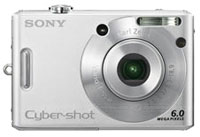 Ahead of the big PMA (Photo Marketing Association International) show at the end of the month in Florida, Sony has announced two new 6-megapixel cameras in their ‘W’ range.
Ahead of the big PMA (Photo Marketing Association International) show at the end of the month in Florida, Sony has announced two new 6-megapixel cameras in their ‘W’ range.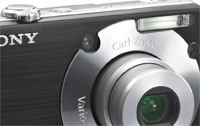 Looking somewhat reminiscent of the Canon Ixus / Elph range, the miniaturised, re-engineered W-series offers a compact, highly pocketable design (89x59x23mm) with a price that’s easy on the pocket too, with the DSC-W30 retailing for $230 (~£132, ~e193) and the DSC-W50 for $250 (~£143, ~e209).
Looking somewhat reminiscent of the Canon Ixus / Elph range, the miniaturised, re-engineered W-series offers a compact, highly pocketable design (89x59x23mm) with a price that’s easy on the pocket too, with the DSC-W30 retailing for $230 (~£132, ~e193) and the DSC-W50 for $250 (~£143, ~e209).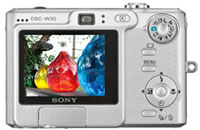 At higher ISO ratings noise can become a real issue, but Sony are claiming that their Clear RAW imaging technology keeps the multi-colour snow-storm effect to a minimum.
At higher ISO ratings noise can become a real issue, but Sony are claiming that their Clear RAW imaging technology keeps the multi-colour snow-storm effect to a minimum.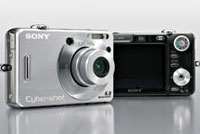 To help fumbling newbies and the easily baffled, Sony has added a new function guide which displays a short onscreen text explanation whenever a shooting mode is selected. This can be turned off once the user becomes familiar with the icons on the mode dial.
To help fumbling newbies and the easily baffled, Sony has added a new function guide which displays a short onscreen text explanation whenever a shooting mode is selected. This can be turned off once the user becomes familiar with the icons on the mode dial. Scene modes Twilight, Twilight Portrait,Landscape,Beach,Snow,Soft Snap
Scene modes Twilight, Twilight Portrait,Landscape,Beach,Snow,Soft Snap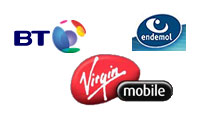 They’ve been busy boys at BT this week, with the UK telecoms giant making two major announcements.
They’ve been busy boys at BT this week, with the UK telecoms giant making two major announcements. Using the UK’s existing digital audio broadcasting (DAB) network, the broadcast service will be offered on a limited exclusive basis to virgin Mobile customers later this year. BT Movio will be available in the future to all mobile operators in the UK.
Using the UK’s existing digital audio broadcasting (DAB) network, the broadcast service will be offered on a limited exclusive basis to virgin Mobile customers later this year. BT Movio will be available in the future to all mobile operators in the UK.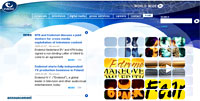 Microsoft partnership
Microsoft partnership ‘The Apprentice’ TV show has been a smash hit in the UK, much the same as it was in the US. The BBC now plan to use it as the ‘first extensive broadband experience,’ as part of the BBC TV Plus project.
‘The Apprentice’ TV show has been a smash hit in the UK, much the same as it was in the US. The BBC now plan to use it as the ‘first extensive broadband experience,’ as part of the BBC TV Plus project.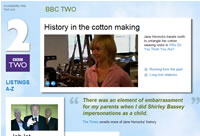 Initially looking at these advances it’s easy to get excited, but when looked in context of how long it’s taken, a frustrations come to the surface.
Initially looking at these advances it’s easy to get excited, but when looked in context of how long it’s taken, a frustrations come to the surface.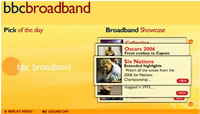 (Funnily enough, after reading that article the person responsible for the project contacted us and it turned out to be someone whose previous work outside the BBC we’d been very impressed with.)
(Funnily enough, after reading that article the person responsible for the project contacted us and it turned out to be someone whose previous work outside the BBC we’d been very impressed with.) Keen to further expand their vice-like grip on the portable digital music market, Apple have unveiled a cut-down 1GB version of their turbo box-shifting iPod Nano player.
Keen to further expand their vice-like grip on the portable digital music market, Apple have unveiled a cut-down 1GB version of their turbo box-shifting iPod Nano player.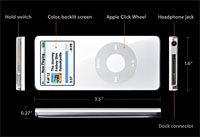 The new 1GB Nano can hold up to 240 songs or 15,000 photographs and comes with all the usual Nano features, including the colour display and docking connector.
The new 1GB Nano can hold up to 240 songs or 15,000 photographs and comes with all the usual Nano features, including the colour display and docking connector.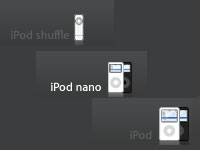 As Shaw Wu, an analyst with American Technology Research, put it: “Apple is selling a $69 MP3 player with the best software. How do you compete with that? It’s tough.”
As Shaw Wu, an analyst with American Technology Research, put it: “Apple is selling a $69 MP3 player with the best software. How do you compete with that? It’s tough.” The iPod range continues to be an outrageously successful money spinner for Apple, with around 32 million iPods shifted last year, including 14 million during the holiday season.
The iPod range continues to be an outrageously successful money spinner for Apple, with around 32 million iPods shifted last year, including 14 million during the holiday season. T-Mobile was told to see the headmaster and returned with a derrier rouge after making exaggerated claims about its “web’n’walk” mobile Internet service.In a wave of PR-driven hyperbole
T-Mobile was told to see the headmaster and returned with a derrier rouge after making exaggerated claims about its “web’n’walk” mobile Internet service.In a wave of PR-driven hyperbole 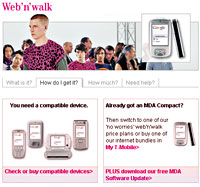 T-Mobile had a valiant stab at a defence, arguing that their advert was all about making the distinction between Ye Olde Crappe WAP and their new, full Internet-access, web’n’walk service, adding that they had included the line, “subject to coverage”.
T-Mobile had a valiant stab at a defence, arguing that their advert was all about making the distinction between Ye Olde Crappe WAP and their new, full Internet-access, web’n’walk service, adding that they had included the line, “subject to coverage”. To the sound of a salvo of slapped wrists, the statement concluded that the ad, “was misleading because readers were likely to interpret the claim to refer to geographical network coverage. We told T-Mobile to avoid making such unconditional claims in future advertising.”
To the sound of a salvo of slapped wrists, the statement concluded that the ad, “was misleading because readers were likely to interpret the claim to refer to geographical network coverage. We told T-Mobile to avoid making such unconditional claims in future advertising.” Apple have announced a competition to become the downloader of the 1 Billion th music track on iTMS.
Apple have announced a competition to become the downloader of the 1 Billion th music track on iTMS.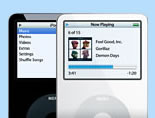 At the time of writing, we see on the live track count that they’ve sold just short of 950,981,000 tracks.
At the time of writing, we see on the live track count that they’ve sold just short of 950,981,000 tracks. You know we like to save you money when we can and for those with sharp eyes, you’ll see near at the bottom of the page in light grey (thanks Apple), “*No purchase necessary to win. Click here to submit a free entry form.” Following the link takes you to the form telling that you can indeed make up to 25 free entries a day. We’re not sure on the US rules for competitions, but we know in the UK that free entry is essential when there’s no skill involved with entering the competition.
You know we like to save you money when we can and for those with sharp eyes, you’ll see near at the bottom of the page in light grey (thanks Apple), “*No purchase necessary to win. Click here to submit a free entry form.” Following the link takes you to the form telling that you can indeed make up to 25 free entries a day. We’re not sure on the US rules for competitions, but we know in the UK that free entry is essential when there’s no skill involved with entering the competition.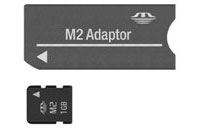 If you’ve owned a few digital cameras or PDAs and switched brands a couple of times over the years, you’ll probably already have a formidable collection of non-compatible memory cards wasting away in your drawer.
If you’ve owned a few digital cameras or PDAs and switched brands a couple of times over the years, you’ll probably already have a formidable collection of non-compatible memory cards wasting away in your drawer.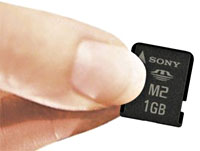 Much as we hate to give any kudos to yet another memory card format, that’s a mighty impressive capacity and offers enough storage space to turn mobile phones into fully fledged, iPod-worrying MP3 players.
Much as we hate to give any kudos to yet another memory card format, that’s a mighty impressive capacity and offers enough storage space to turn mobile phones into fully fledged, iPod-worrying MP3 players.